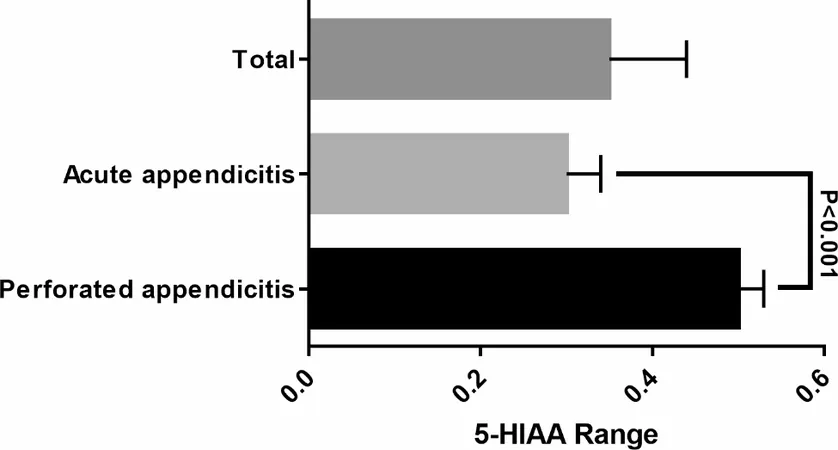
Unlocking Appendicitis Diagnosis: The Promise of 5-Hydroxyindoleacetic Acid as a Crucial Biomarker
2024-10-14
Author: William
Introduction
In a groundbreaking study, researchers have explored the potential of 5-hydroxyindoleacetic acid (5-HIAA) as a valuable biomarker for distinguishing between perforated and non-perforated cases of acute appendicitis. This discovery is crucial for timely diagnosis and effective surgical planning, as complications from appendicitis can escalate rapidly, leading to serious health risks.
Methodology Overview
Conducted as a prospective study among patients diagnosed with acute appendicitis, the research involved measuring 5-HIAA levels from urine samples collected before surgeries. The patients were subsequently divided into two groups based on pathological confirmation: those with perforated appendicitis and those with uncomplicated cases. Various diagnostic metrics, including sensitivity and specificity, were calculated using SPSS v.27 to assess the reliability of 5-HIAA levels in determining perforation.
Key Findings
Out of 150 patients, 40 were classified into the perforated appendicitis category, while 110 belonged to the noncomplicated group. With an average age of around 29 years across both groups and a gender distribution favoring males (63%), the study highlighted a significant difference in 5-HIAA concentrations: an average of 0.5 mg/dl in perforated cases compared to 0.3 mg/dl in non-perforated cases (P < 0.001). The diagnostic analysis revealed a sensitivity of 82%, specificity of 62%, and diagnostic accuracy of 88%, underscoring the potential clinical application of this biomarker.
Why This Matters
Acute appendicitis is notorious for its overlapping symptoms with a range of other medical conditions, leading to misdiagnoses and treatment delays. Such delays can result in perforation, which significantly complicates treatment and can lead to severe consequences like peritonitis. The use of 5-HIAA not only offers a non-invasive diagnostic tool but also promises to reduce reliance on costly imaging techniques, making it particularly beneficial for vulnerable populations, including pregnant women.
Moreover, the original study suggests that the type of surgical incision employed can be optimized based on the presence or absence of perforation—making accurate pre-operative diagnosis essential.
Understanding the Mechanism
The appendix contains enterochromaffin cells that synthesize and store serotonin (5-HT). In inflammatory conditions such as appendicitis, blood serotonin levels surge, leading the liver to metabolize 5-HT into 5-HIAA, which is then excreted in urine. Consequently, elevated levels of 5-HIAA have been associated with acute appendicitis, prompting further research into its clinical utility.
Previous studies have yielded mixed findings regarding the reliability of 5-HIAA in diagnosing appendicitis. While some suggest it may effectively indicate early appendicitis, its role in differentiating between complicated and uncomplicated cases remains debated. This highlights the need for more extensive research, particularly considering variations in sample sizes and methods across different studies.
Limitations and Future Directions
The current study, while pioneering, faced challenges due to its relatively small sample size, limitations exacerbated by the COVID-19 pandemic. As it stands, there are no equivalent studies conducted in the nation, marking this research as a significant initial exploration into the use of 5-HIAA in appendicitis diagnostics.
In conclusion, the findings advocate for further large-scale studies to establish 5-HIAA as a reliable clinical marker, refine the threshold values for diagnostics, and ultimately contribute to improved patient outcomes in acute appendicitis cases.
Stay tuned for more updates in the field of medical diagnostics, where a simple urine test might soon change the way we manage one of the most common surgical emergencies!









 Brasil (PT)
Brasil (PT)
 Canada (EN)
Canada (EN)
 Chile (ES)
Chile (ES)
 España (ES)
España (ES)
 France (FR)
France (FR)
 Hong Kong (EN)
Hong Kong (EN)
 Italia (IT)
Italia (IT)
 日本 (JA)
日本 (JA)
 Magyarország (HU)
Magyarország (HU)
 Norge (NO)
Norge (NO)
 Polska (PL)
Polska (PL)
 Schweiz (DE)
Schweiz (DE)
 Singapore (EN)
Singapore (EN)
 Sverige (SV)
Sverige (SV)
 Suomi (FI)
Suomi (FI)
 Türkiye (TR)
Türkiye (TR)